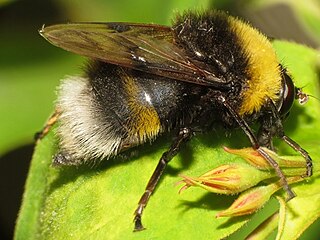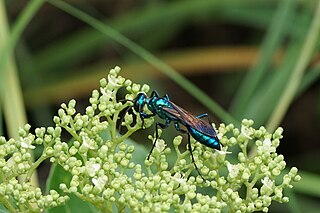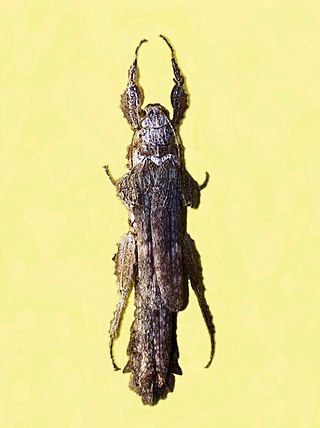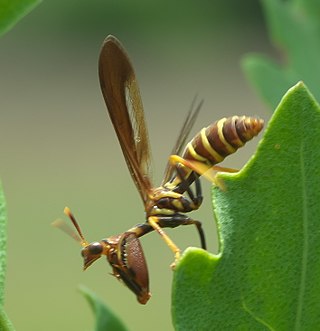
Amédée Louis Michel le Peletier, comte de Saint-Fargeau, also spelled Lepeletier or Lepelletier, was a French entomologist, and specialist in the Hymenoptera.

Jean Guillaume Audinet-Serville was a French entomologist, born on 11 November 1775 in Paris. He died on 27 March 1858 in La Ferté-sous-Jouarre.

Arginae is a subfamily of argid sawflies in the family Argidae. There are about 12 genera and more than 400 described species in Arginae.

Haematobia is a genus of biting true flies of the family Muscidae.

Pocota is a genus hoverflies, from the family Syrphidae, in the order Diptera.

Ornidia is a small genus of mid-sized metallic hoverflies.

The Milesiini is a large and diverse tribe of hoverflies. They mimic wasps or hornets.

The Volucellini is a tribe of hoverflies.

Chlorion is a genus of parasitoid wasps in the family Sphecidae. Species have been recorded from the Americas, Africa and tropical Asia through to Java; they appear to prey mostly on Orthopteran insects.
Tapeina is a genus of Neotropical longhorn beetles in the subfamily Lamiinae. It is the only genus in the tribe Tapeinini.

Belostoma is a genus of insects in the hemipteran family Belostomatidae, known colloquially as giant water bugs. Members of this genus are native to freshwater habitats in the Americas, with the greatest species richness in tropical South America. Most species in the family Belostomatidae have historically been included in Belostoma, but several of these have been moved to other genera. 9 species are claimed to be found in Northern America, but the genus Belostoma is actually divided into 16 subgroups containing about 70 species.

Prisopus is a genus of stick insects belonging to the family Prisopodidae. These stick insects are present in Central and South America, India and Malesia.

Macrodactylini is a tribe of May beetles and junebugs in the family Scarabaeidae. There are at least 46 genera and over a thousand species described in the tribe Macrodactylini.
Palmodes is a genus of thread-waisted wasps in the family Sphecidae. There are more than 20 described species in Palmodes.

Perreyiinae is a subfamily of sawflies in the family Pergidae. There are about 16 genera and more than 90 described species in Perreyiinae.

Climaciella is a genus of wasp mantidflies in the family Mantispidae. There are about 10 described species in Climaciella, found in North, Central, and South America. Climaciella brunnea, a wasp mimic, is a common species found in Central and North America.

Evacanthus is a genus of leafhoppers belonging to the family Cicadellidae.

Tetragona is a genus of bees belonging to the family Apidae.

Rhathymus is a genus of cuckoo bees belonging to the family Apidae.

The Cladomorphinae are a subfamily of stick insects in the family Phasmatidae. This taxon is particularly well represented in the Neotropical region, but records also exist for Madagascar, Java and the Maluku Islands.

















